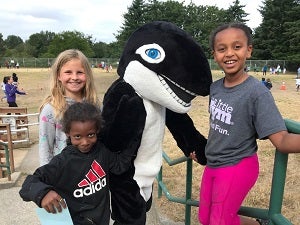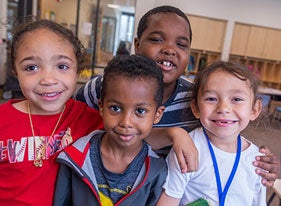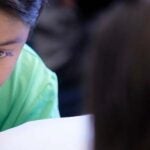2nd Grade
A Family Guide to 2nd Grade
In every grade, SPS’ core work is supporting student learning. We believe it is our responsibility to do whatever it takes to ensure that every child, regardless of race, gender, socioeconomic status, language proficiency, learning style or disability, achieves to their highest level.
It’s time for 2nd grade, and your child already knows a lot!
They have some experience with school and have information in many areas. They may challenge you with their ability to remember facts.
Their teachers recognize their interest in detail and are helping them to notice more about the characters, actions and descriptions in what they read. They should be encouraged to write and retell stories with more detail as well and pay attention to the world around them in science and social studies.
Many 2nd graders start to fear making mistakes. You can help them slow down to give accurate answers to math problems, look up and define new words, and take care with grammar and spelling.
They need security and structure, so it helps to have familiar patterns and expectations at school and at home. Talk with your child’s teachers about how they spend time in class and outside school. Together you can create predictable routines to help your learner feel supported.
Important Dates
September
- 1st day of school
November
- Parent-Teacher Conferences
December
- End of 1st Trimester; 1st Progress Report Available
March
- End of 2nd Trimester; 2nd Progress Report Available
June
- End of 3rd Trimester; 3rd Progress Report Available
Student Progress Reports
Second graders can make lists and check progress. They can see the report card standards as challenges. Help them to believe in themselves and set goals for growth. But make room for laughter so they see that learning can be fun!
Remember that children’s brains develop both academically and socially. Work together with your child and their teachers to discuss social-emotional and learning readiness skills. Build interest in learning language arts, math, science, social studies, physical education, arts and more!
How to Access Progress Reports
Families will use The Source to view Student Progress Reports.
Parent and guardians can create an account with the email on record at their student’s school.
Student Success by Subject
Social Emotional Learning
At Seattle Public Schools we believe that social emotional learning prepares students for learning and life.

Social emotional learning (SEL) helps children:
• Manage emotions, show empathy
• Develop a healthy identity
• Make responsible decisions
• Have positive relationships
• Contribute to their community
These skills are important for learning and life.
At school, students learn and practice SEL skills throughout the day.
Reading and Writing
In English language arts (ELA), 2nd grade students learn to:
- Read and understand grade-level text and figure out meaning of unknown words when reading
- Retell what is read, using key details from the text
- Ask questions about their reading
- Describe characters, settings, and events in stories
- Start to determine and identify topics and big ideas in a text
- Write and draw and add details to communicate for different purposes
- Take part in collaborative conversations about their learning and what they have read
Encourage reading at home with your child. Read to them or listen to them read every day.
Math
In 2nd grade math, students will build on their 1st grade understanding of the Base-10 number system to:

- Work with numbers up to 1,000 and understand the value of each digit
- Use addition and subtraction to solve problems within 100
- Learn addition and subtraction facts within 20
- Understand the relationship between addition and subtraction
- Work with equal groups as a foundation to multiplication.
- Understands units of measure, including length, time and money
- Describe and analyze two-dimensional and three-dimensional shapes based on their attributes.
We believe all students have mathematical brilliance. Your child’s teacher seeks to cultivate brilliance to develop your child into a mathematical thinker and problem solver. Your child will see who sees the value of math in their life.
Science
What are 2nd graders learning in science?
This is a time for transition in science education, with teaching and learning focused on three key areas in Washington state Science Learning Standards:
- Science/engineering practices used by professionals to explain the world or solve problems
- Core ideas that include fundamental scientific knowledge
- Crosscutting concepts frame scientific thinking across life, earth/space, physical sciences.
Your child’s report card shows performance expectations, for what students should be able to do by the end of a unit. The three dimensions are woven into each performance expectation.
Get outside together, taking time to notice, appreciate, and wonder about the natural world.
Social Studies
What’s important about 2nd grade social studies?
The report card shows five areas of social studies that you and your child can discuss.
- Civics – Understanding the role of government and involvement in a community
- Economics – Understanding that choices among goods and services have costs and benefits to a local community
- Geography – Gaining information from maps and globes; Understanding that peo- ple in a community impact the environment
- History – Using a timeline to show community events in a sequence
- Social Studies Skills – Using questions to find information in technology and print
Physical Education
In physical education (PE), students build movement skills, knowledge, fitness, social well being, and confidence so they can enjoy a healthy, active lifestyle. Seattle Public Schools is committed to providing a quality physical education program to help students develop in these areas.
Our PE standards are based on motor and movement patterns and skills, as well as concepts like physical literacy, which is the ability, confidence, and desire to be physically active for life. PE is an instructional program, which makes it different from recess, free play, recreational sports, or athletics.
PE teachers work with general education teachers to provide high quality instruction for an average of 100 minutes per week, which is required by Washington state law. Schools organize PE times in different ways, but all students should be learning about their physical selves all year long!
Visual and Performing Arts
Research shows that students with an arts education are more engaged, do better in school, and are more likely to graduate and participate in community life. In Seattle Public Schools, we want every student to receive a comprehensive, predictable arts education during their K-12 years.
Each elementary school offers different arts programs, from possibilities including visual arts, general music, theatre, dance, or instrumental music.
Progress report standards come from the Washington state Arts Learning Standards, which focus on aspects of artistic process:
- Creating: developing new artistic ideas and work.
- Performing: interpreting and presenting artistic ideas / work
- Responding: understanding and evaluating meaning in the arts
- Connecting: Relating personally to artistic ideas and work
The arts are a core subject!
Make art together!

